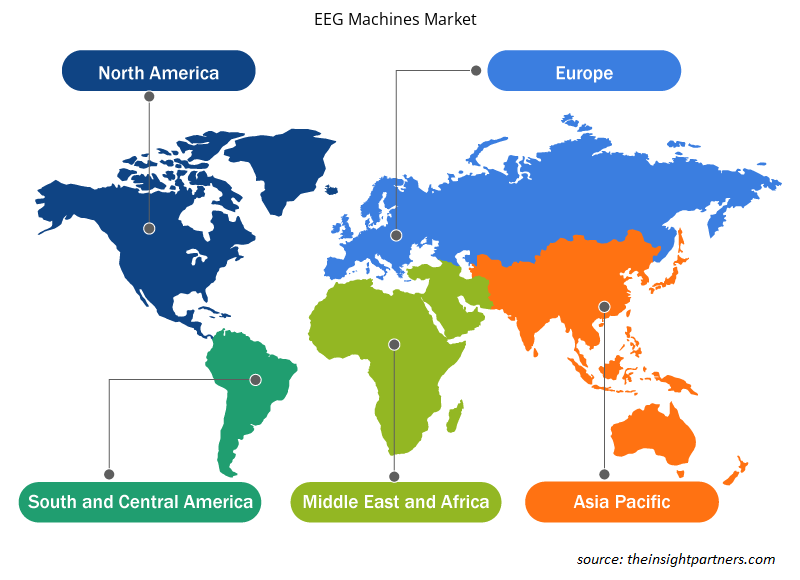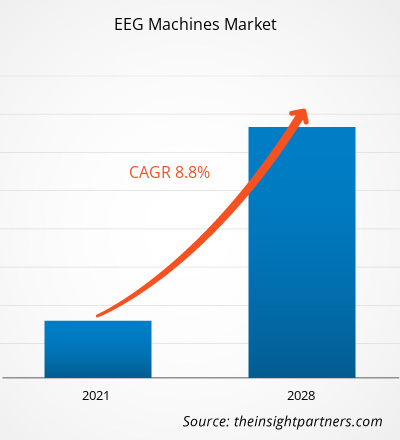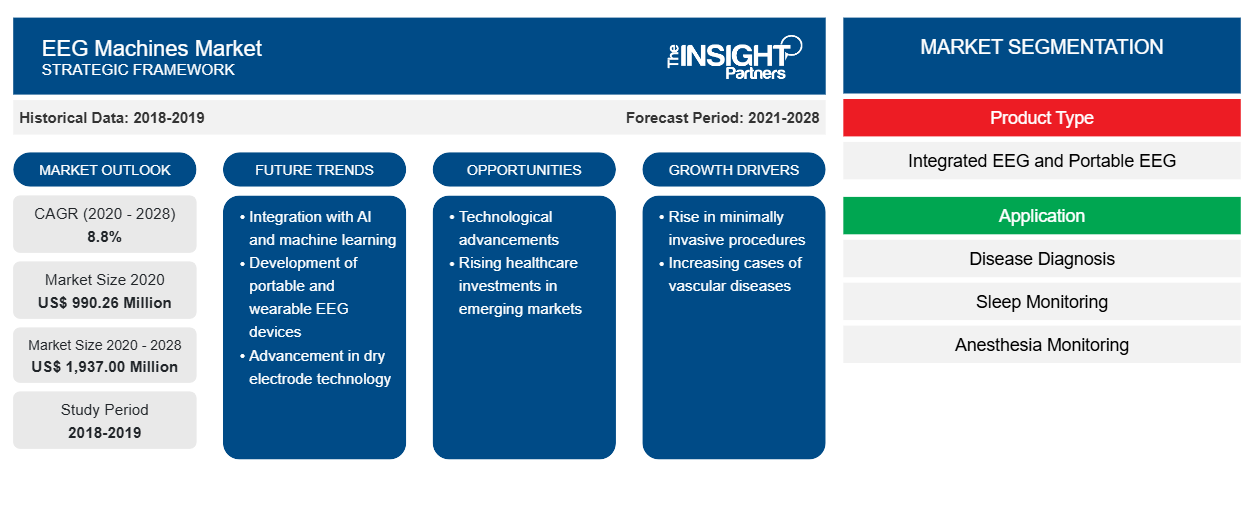[Forschungsbericht] Der Markt für EEG-Geräte wurde im Jahr 2020 auf 990,26 Millionen US-Dollar geschätzt und soll bis 2028 1.937,00 Millionen US-Dollar erreichen; von 2021 bis 2028 wird ein durchschnittliches jährliches Wachstum von 8,8 % erwartet.
Ein Elektroenzephalographiegerät (EEG) ist ein medizinisches Gerät, mit dem medizinisches Fachpersonal die elektrischen Signale des Gehirns überwachen kann. Die übertragenen elektrischen Signale sind relativ schwach und müssen daher verstärkt werden. Ein Verstärker wird verwendet, um die Spannung zu erhöhen. Die Messwerte eines EEG-Geräts werden verwendet, um verschiedene neurologische Störungen zu diagnostizieren und Schlafstörungen sowie Patienten unter Narkose während medizinischer Verfahren wie Operationen zu überwachen. Das Gerät arbeitet mit Hilfe von Elektroden, die an der Kopfhaut angebracht sind, um die Messwerte der Gehirnwellen zu erfassen. EEG-Geräte werden hauptsächlich in Krankenhäusern, Diagnoselabors und ambulanten Operationszentren verwendet.
Der Markt für EEG-Geräte ist nach Produkttyp, Anwendung, Endbenutzer und Geografie segmentiert. Basierend auf der Geografie ist der Markt in Nordamerika, Europa, Asien-Pazifik, Naher Osten und Afrika sowie Süd- und Mittelamerika segmentiert. Der Bericht bietet Einblicke und eine eingehende Analyse des Marktes für EEG-Geräte und betont dabei verschiedene Parameter wie Markttrends, technologische Fortschritte, Marktdynamik und Wettbewerbslandschaftsanalyse führender Marktteilnehmer auf der ganzen Welt. Es enthält auch eine COVID-19-Auswirkungsanalyse in allen Regionen. Es wird geschätzt, dass der Markt im Prognosezeitraum aufgrund der eingeschränkten Gesundheitsdienste und der durch die COVID-19-Pandemie verursachten Lockdown-Situation wahrscheinlich eine langsamere Wachstumsrate aufweisen wird.
Passen Sie diesen Bericht Ihren Anforderungen an
Sie erhalten kostenlos individuelle Anpassungen an jedem Bericht, einschließlich Teilen dieses Berichts oder einer Analyse auf Länderebene, eines Excel-Datenpakets sowie tolle Angebote und Rabatte für Start-ups und Universitäten.
- Holen Sie sich die wichtigsten Markttrends aus diesem Bericht.Dieses KOSTENLOSE Beispiel umfasst eine Datenanalyse von Markttrends bis hin zu Schätzungen und Prognosen.
Markteinblicke
Zunehmende neurologische Störungen
Bei älteren Menschen kommt es immer häufiger zu neurologischen Erkrankungen. Aufgrund verschiedener Faktoren wie Stress, genetischer Mutationen, Lebensgewohnheiten und damit verbundenen chronischen Erkrankungen treten sie jedoch bei Menschen aller Altersgruppen auf. Schätzungen zufolge gibt es über 600 neurologische Erkrankungen, darunter häufig Parkinson, Huntington, Alzheimer, Muskeldystrophie, Schlaganfall, Meningitis, Epilepsie, Demenz, Migräne und Hirntumore.
Laut dem Bericht „Global Burden of Disease“, der 2017 in JAMA Neurology veröffentlicht wurde, wurden in den USA die behinderungsbereinigten Lebensjahre (DALYs) für die meisten belastenden Krankheiten wie Schlaganfall, Migräne, Alzheimer und andere Demenzerkrankungen untersucht. Die DALYs für Schlaganfall lagen bei 3,58 Millionen, für Alzheimer und andere Demenzerkrankungen bei 2,55 Millionen und für Migräne bei 2,4 Millionen. Es wird geschätzt, dass die Inzidenz in Zukunft wahrscheinlich zunehmen wird, da die Inzidenzrate bei Meningitis (44,8 %), traumatischer Hirnverletzung (44,8 %), Rückenmarksverletzung (29,1 %) und Enzephalitis (38,5 %) gleich hoch ist.JAMA Neurology 2017, disability-adjusted life-years (DALYs) for most burdensome diseases, such as stroke, migraine, and Alzheimer’s disease, and other dementias, were studied in the US. DALYs for stroke were 3.58 million, for Alzheimer’s disease and other dementias 2.55 million, and for migraine 2.4 million. It is estimated that the incidence is likely to increase in the future with the incidence rate of meningitis (44.8%), traumatic brain injury (44.8%), spinal cord injury (29.1%), and encephalitis (38.5%).
Ebenso wird erwartet, dass die wachsende geriatrische Bevölkerung die Häufigkeit neurologischer Erkrankungen beeinflusst. Laut dem 2018 veröffentlichten Bericht der Weltgesundheitsorganisation (WHO) wird die Gesamtbevölkerung über 60 Jahre bis 2050 um 22 % wachsen, von 12 % im Jahr 2015. Laut dem 2016 veröffentlichten Federal Interagency Forum on Aging-Related Statistics leiden 35,8 % der Menschen ab 85 Jahren an mittelschweren oder schweren Gedächtnisstörungen. Aufgrund der oben genannten Statistiken wird daher erwartet, dass die Nachfrage nach EEG-Geräten steigen wird, was wiederum das Marktwachstum ankurbeln wird.
Produkttypbasierte Einblicke
Basierend auf dem Produkttyp ist der Markt für EEG-Geräte in integrierte und tragbare EEG-Geräte unterteilt. Das Segment der integrierten EEG-Geräte hatte 2020 den größten Marktanteil. Es wird jedoch erwartet, dass das Segment der tragbaren EEG-Geräte im Prognosezeitraum die höchste durchschnittliche jährliche Wachstumsrate (CAGR) auf dem Markt verzeichnet. Das Wachstum des Segments der tragbaren EEG-Geräte ist auf technologische Fortschritte zurückzuführen, die eine Echtzeit-Erfassung der Gehirnaktivität ermöglichen, die relativ kostengünstig und nicht invasiv ist.CAGR in the market during the forecast period. The growth of portable EEG segment can be attributed to technological advancements that offer real-time brain activity, which is relatively inexpensive, and non-invasive.
Anwendungsbasierte Erkenntnisse
Basierend auf der Anwendung ist der Markt für EEG-Geräte in Krankheitsdiagnose, Schlafüberwachung, Anästhesieüberwachung, Trauma und Chirurgie und andere unterteilt. Das Segment Krankheitsdiagnose hatte im Jahr 2020 den größten Marktanteil, außerdem wird erwartet, dass das Segment im Prognosezeitraum die höchste durchschnittliche jährliche Wachstumsrate (CAGR) auf dem Markt verzeichnet.CAGR in the market during the forecast period.
Endbenutzerbasierte Erkenntnisse
Basierend auf dem Endverbraucher ist der Markt für EEG-Geräte in Krankenhäuser, Diagnosezentren, ambulante chirurgische Zentren, Forschungslabore und andere unterteilt. Das Segment Krankenhäuser hatte im Jahr 2020 den größten Marktanteil, jedoch wird erwartet, dass das Segment Diagnosezentren im Prognosezeitraum die höchste durchschnittliche jährliche Wachstumsrate (CAGR) auf dem Markt verzeichnet.CAGR in the market during the forecast period.
Die Marktteilnehmer verfolgten gleichermaßen organische und anorganische Strategien, um der veränderten Kundennachfrage gerecht zu werden und ihre verbesserten Dienstleistungen aufrechtzuerhalten. So verfolgte Fresenius Kabi im Februar 2021 eine organische Expansionsstrategie. Das Unternehmen investierte in die Weiterentwicklung seiner Einrichtungen auf der ganzen Welt, um die Versorgung schwer und chronisch kranker Patienten zu unterstützen, ganz im Einklang mit der Unternehmensphilosophie „Caring for Life“. Darüber hinaus investierte Fresenius Kabi weiterhin in seine beiden Grazer Einrichtungen.
Regionale Einblicke in den Markt für EEG-Geräte
Die regionalen Trends und Faktoren, die den Markt für EEG-Geräte im Prognosezeitraum beeinflussen, wurden von den Analysten von Insight Partners ausführlich erläutert. In diesem Abschnitt werden auch die Marktsegmente und die Geografie für EEG-Geräte in Nordamerika, Europa, im asiatisch-pazifischen Raum, im Nahen Osten und Afrika sowie in Süd- und Mittelamerika erörtert.

- Erhalten Sie regionale Daten zum Markt für EEG-Geräte
Umfang des Marktberichts zu EEG-Geräten
| Berichtsattribut | Details |
|---|---|
| Marktgröße im Jahr 2020 | 990,26 Millionen US-Dollar |
| Marktgröße bis 2028 | 1.937,00 Millionen US-Dollar |
| Globale CAGR (2020 - 2028) | 8,8 % |
| Historische Daten | 2018-2019 |
| Prognosezeitraum | 2021-2028 |
| Abgedeckte Segmente | Nach Produkttyp
|
| Abgedeckte Regionen und Länder | Nordamerika
|
| Marktführer und wichtige Unternehmensprofile |
|
Dichte der Marktteilnehmer für EEG-Geräte: Auswirkungen auf die Geschäftsdynamik verstehen
Der Markt für EEG-Geräte wächst rasant. Die Nachfrage der Endverbraucher steigt aufgrund von Faktoren wie sich entwickelnden Verbraucherpräferenzen, technologischen Fortschritten und einem größeren Bewusstsein für die Vorteile des Produkts. Mit der steigenden Nachfrage erweitern Unternehmen ihr Angebot, entwickeln Innovationen, um die Bedürfnisse der Verbraucher zu erfüllen, und nutzen neue Trends, was das Marktwachstum weiter ankurbelt.
Die Marktteilnehmerdichte bezieht sich auf die Verteilung von Firmen oder Unternehmen, die in einem bestimmten Markt oder einer bestimmten Branche tätig sind. Sie gibt an, wie viele Wettbewerber (Marktteilnehmer) in einem bestimmten Marktraum im Verhältnis zu seiner Größe oder seinem gesamten Marktwert präsent sind.
Die wichtigsten auf dem Markt für EEG-Geräte tätigen Unternehmen sind:
- Koninklijke Philips NV
- Medtronic
- Natus Medical Incorporated
- Nihon Kohden Corporation
- Fresenius SE & Co. KGaA
Haftungsausschluss : Die oben aufgeführten Unternehmen sind nicht in einer bestimmten Reihenfolge aufgeführt.

- Überblick über die wichtigsten Akteure auf dem Markt für EEG-Geräte
Nach Produkttyp
- Integriertes EEG
- Tragbares EEG
Nach Anwendung
- Krankheitsdiagnose
- Schlafüberwachung
- Anästhesieüberwachung
- Trauma und Chirurgie
- Sonstiges
Nach Endbenutzer
- Krankenhäuser
- Diagnostikzentren
- Ambulante Chirurgische Zentren
- Forschungslabore
- Sonstiges
Nach Geografie
Nordamerika
- UNS
- Kanada
- Mexiko
Europa
- Frankreich
- Deutschland
- Italien
- Vereinigtes Königreich
- Spanien
- Restliches Europa
Asien-Pazifik (APAC)
- China
- Indien
- Südkorea
- Japan
- Australien
- Restlicher Asien-Pazifik-Raum
Naher Osten und Afrika (MEA)
- Südafrika
- Saudi-Arabien
- Vereinigte Arabische Emirate
- Rest von MEA
Süd- und Mittelamerika (SCAM)
- Brasilien
- Argentinien
- Rest von SCAM
Firmenprofile
- Koninklijke Philips NV
- Medtronic
- Natus Medical Incorporated
- Nihon Kohden Corporation
- Fresenius SE & Co. KGaA
- Erweiterte Gehirnüberwachung
- D & DJ BURTON HOLDINGS
- Cephalon A/S
- Cadwell Industries Inc.,
- NeuroStyle Ptd. Ltd.
- Historische Analyse (2 Jahre), Basisjahr, Prognose (7 Jahre) mit CAGR
- PEST- und SWOT-Analyse
- Marktgröße Wert/Volumen – Global, Regional, Land
- Branchen- und Wettbewerbslandschaft
- Excel-Datensatz
Aktuelle Berichte
Verwandte Berichte
Erfahrungsberichte
Grund zum Kauf
- Fundierte Entscheidungsfindung
- Marktdynamik verstehen
- Wettbewerbsanalyse
- Kundeneinblicke
- Marktprognosen
- Risikominimierung
- Strategische Planung
- Investitionsbegründung
- Identifizierung neuer Märkte
- Verbesserung von Marketingstrategien
- Steigerung der Betriebseffizienz
- Anpassung an regulatorische Trends





















 Kostenlose Probe anfordern für - Markt für EEG-Geräte
Kostenlose Probe anfordern für - Markt für EEG-Geräte